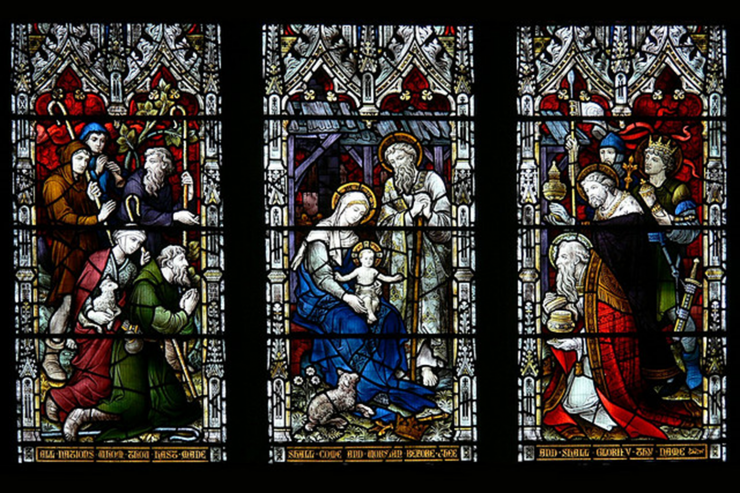by Sister Benedicta Marie, O.C.D.
Carmelite Sisters of the Most Sacred Heart of Los Angeles
The Bible expresses the eternal and immutable Word of God, not on nautical charts with cartographer’s symbols, but in a ‘map’ whose symbols are those of literature.

Photography © by Carmelite Sisters
The Importance of Formulations and Symbols of Faith
C.S. Lewis (1898-1963), novelist, academic, medievalist, literary critic, essayist, lay theologian and Christian apologist, spoke to an audience comprised of the men and women of the Royal Air Force (R.A.F.) in England. As Lewis, “the Apostle to the Skeptics,” finished his presentation, one old officer stood up, looked Lewis straight in the eye, and retorted,
“I’ve no use for all that stuff. But, mind you, I’m a religious man, too. I know there’s a God. I’ve felt Him out alone in the desert at night – the tremendous mystery. And that’s just why I don’t believe all your neat little dogmas and formulas about Him. To anyone who’s met the real thing, they all seem so petty and pedantic and unreal!”
This R.A.F. officer found dogmas and formulas too small to be the truth about the God he had experienced. He was not and is not alone in his sentiments and, of course, he was also absolutely right.
Are our creeds, dogmas and formulas too small for the realities they articulate? Indeed they are. That is why the Catechism of the Catholic Church (#170) is careful to remind us through the wisdom of St. Thomas Aquinas:
“We do not believe in formulas, but in those realities they express, which faith allows us to touch. All the same, we do approach these realities with the help of formulations of the faith …. ”
If our definitions are so small and ‘unreal’ in contrast with the realities they seek to express that they are called symbols of faith (and that is the most we can ask of human language), why bother with them? What is their value?
Lewis solved the difficulty for his R.A.F. listener by comparing the Christian creeds and formulas to a map of the Atlantic Ocean. A walk by the beach is a real experience of the sea, while the map is only a piece of paper. But there are two very important things to remember about that “bit of colored-on paper” – the map contains the combined knowledge and tested experience of thousands of navigators, not just the glimpse of one man’s walk on the beach, and, secondly, “… if you want to go anywhere, the map is absolutely necessary” no matter how many walks you have taken along the shore (taken from the 23rd chapter of Mere Christianity by C.S. Lewis).
Scripture is the very Word of God expressed in Human Literature and Language
The Bible too has the same limitation, and an even greater task, for scripture presents not merely spiritual and religious truth like the Creed, for example, but the very Word of God. Its limitation is really our limitation: it must represent the “living and enduring Word of God” (1 Peter 1:23) in the human languages of men (CCC #109). It must express infinity in ink, communicate the “mysteries hidden from all ages” in Hebrew, Greek and English (Romans 16:25). This does not happen without the direct assistance of God Himself, and in the case of the formation of the books of the Bible, that assistance is called inspiration. While the many human authors contributing to the Bible truly acted as authors, the scriptures are ‘God-breathed’ in a completely unique way, so that we may consider God Himself to be the primary author of the Bible.
The Bible expresses the eternal and immutable Word of God not on nautical charts with cartographers’ symbols, but in a ‘map’ whose symbols are those of literature – narrative and poetry, allegory and parable, simile and metaphor, analogy and personification – all the arts and devices which carry truth and meaning in human language. God’s absolute power and absolute goodness are testified to any number of times in the sacred text. To sample just this one doctrine of scripture expressed in different types of literature, let us consider a few passages.
The measured, stately, almost liturgical formula of Genesis 1 expresses God’s ease in creating by showing Him drawing each part of the universe out of nothing and into existence with a mere word, “Let there be …. ” A few chapters later, in a dramatic narrative, Abraham lays all that he has ever hoped for on an altar of sacrifice and can do so without resentment because “by faith Abraham, when God tested him … reasoned that God could raise the dead” (Heb 11:17).
In epic poetry, long-suffering Job wrings a tormented act of faith from a heart confused and exhausted:
“Why do I put myself in jeopardy and take my life in my hands? Though he slay me, yet will I hope in him; I will surely defend my ways to his face. Indeed, this will turn out for my deliverance, for no godless man would dare come before him” (Job 13:14-16).
Wisdom literature of Psalms, Proverbs, Ecclesiastes, and others, is a wonder of distillation, drop after drop of the ‘essential oil’ of spiritual saavy: “Trust in the Lord with all your heart and lean not on your own understanding” (Proverbs 3:5).
The unparalleled poet and prophet, Isaiah, challenges a nation weary with disaster and faltering faith, “Who among you fears the Lord and obeys the word of his servant? Let he who walks in the dark, who has no light, trust in the name of the Lord and rely on his God” (Isaiah 50:10).
The Book of Acts, true to its name, doesn’t give many words to concepts, but loves to tell a good story, and the divinely arranged prison escapes of Peter, Paul and Silas in the historical narratives of Chapters 12 and 16 allow no doubt as to the sovereignty and benignity of the Father of the Lord Jesus. (Angels, earthquakes, suicide attempts and even a ‘happy-ever-after’). Read it for yourself!
Paul’s Epistles, sermons by surrogate, press home with insistent power the ultimate faith question: “Who shall separate us from the love of Christ? Shall trouble or hardship or persecution or famine or nakedness or danger or sword? …. No, in all these things we are more than conquerors through him who loved us” (Rom 8:35-37).
Finally, the apocalyptic jewel of the New Testament, the Book of Revelation, gathers the very universe in its arms and proclaims a consummation that only absolute goodness and power could dare to promise:
“Then I saw a new heaven and a new earth, for the first heaven and the first earth had passed away … and I heard a loud voice from the throne saying, ‘Now the dwelling of God is with men, and He will live with them. They will be His people, and God Himself will be with them and be their God. He will wipe every tear from their eyes. There will be no more death or mourning or crying or pain, for the old order of things has passed away.” (Rev. 21:1-4).
We are blessed to live in a literate society, and most of us have been exposed to more than enough literature to enable us to grasp most of what the Bible has to say without going back to school for advanced degrees in literary studies. Most of us are far more intimidated by the idea of reading the Bible than we need to be. Certainly we will run into a difficult passage from time to time. Those who love to untie knots can find ample opportunity to do so, but for those not so inclined, there is no reason at all that we cannot simply keep reading and leave the occasional knot to others. Truth is expressed in the pages of the Bible in literal statements, in symbols, in historical narratives, in fiction accounts, poetry and more, not because the Spirit of God is trying to keep things hidden, but because He is endlessly, continuously revealing. To say that the scriptures express truth in a myriad of ways – in every way that human language has invented to express truth – is not to say that the truth is complex, or obscure, or even hard to get at. It isn’t.
Please help us in our mission to assist readers to integrate their Catholic faith, family and work. Tell your family and friends about this article using both the Recommend and Share buttons below and via email. We value your comments and encourage you to leave your thoughts below. Thank you! – The Editors
To learn more about the Carmelite Sisters of the Most Sacred Heart of Los Angeles, read their biography in the right sidebar and visit their website.
They publish a beautiful print magazine, Spirit of Carmel, and we encourage you to support the work of the sisters with your prayers and through donations and subscriptions to the Spirit of Carmel.
If you are able to help them, please click on the image of their magazine to visit their subscription and donation page.
If you hear God calling you to the religious life, I encourage you to visit their vocations page. – Deacon Mike
Or for more information, please contact:
Sister Grace Helena, OCD, Vocation Directress
920 East Alhambra Road
Alhambra, California 91801














